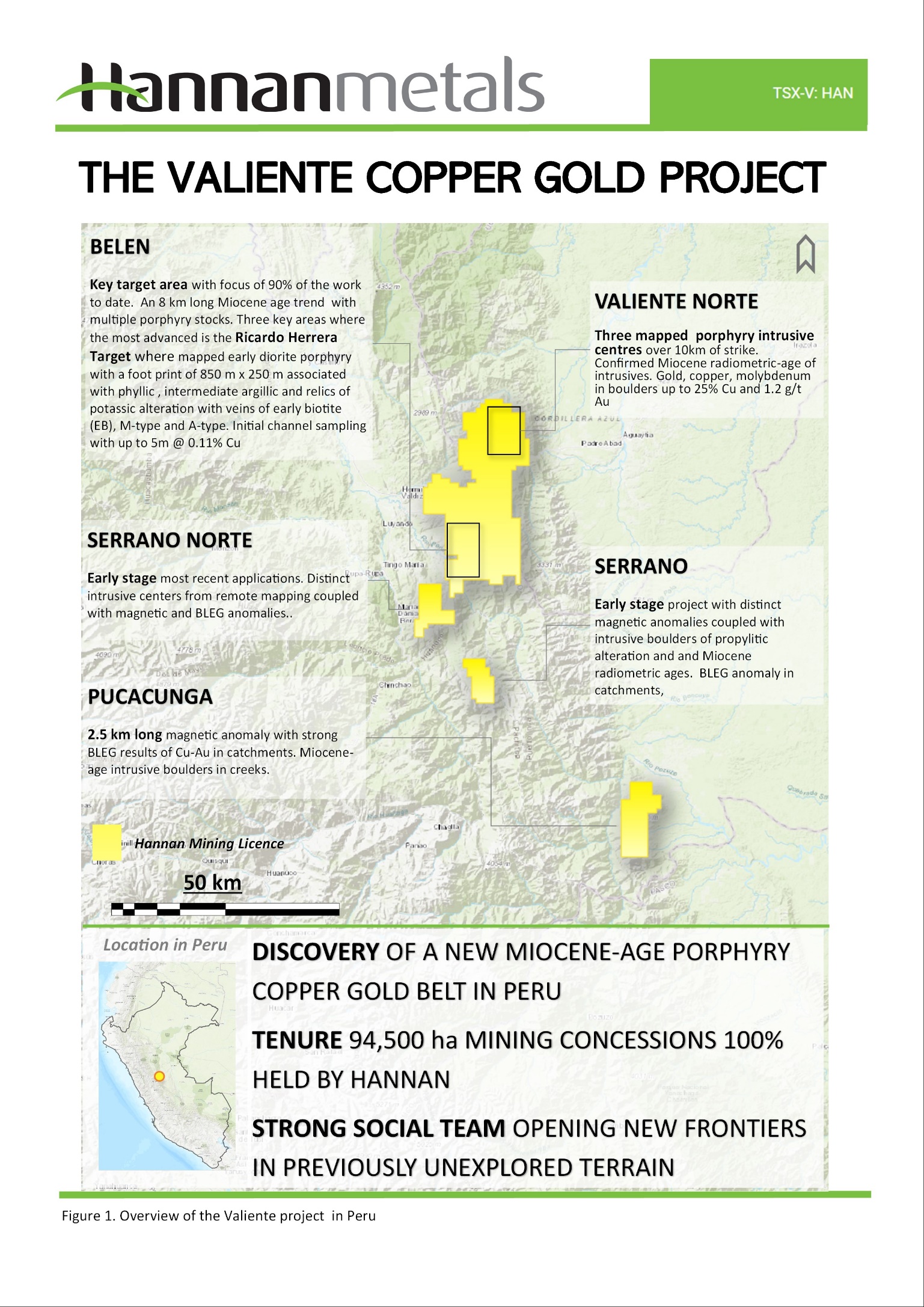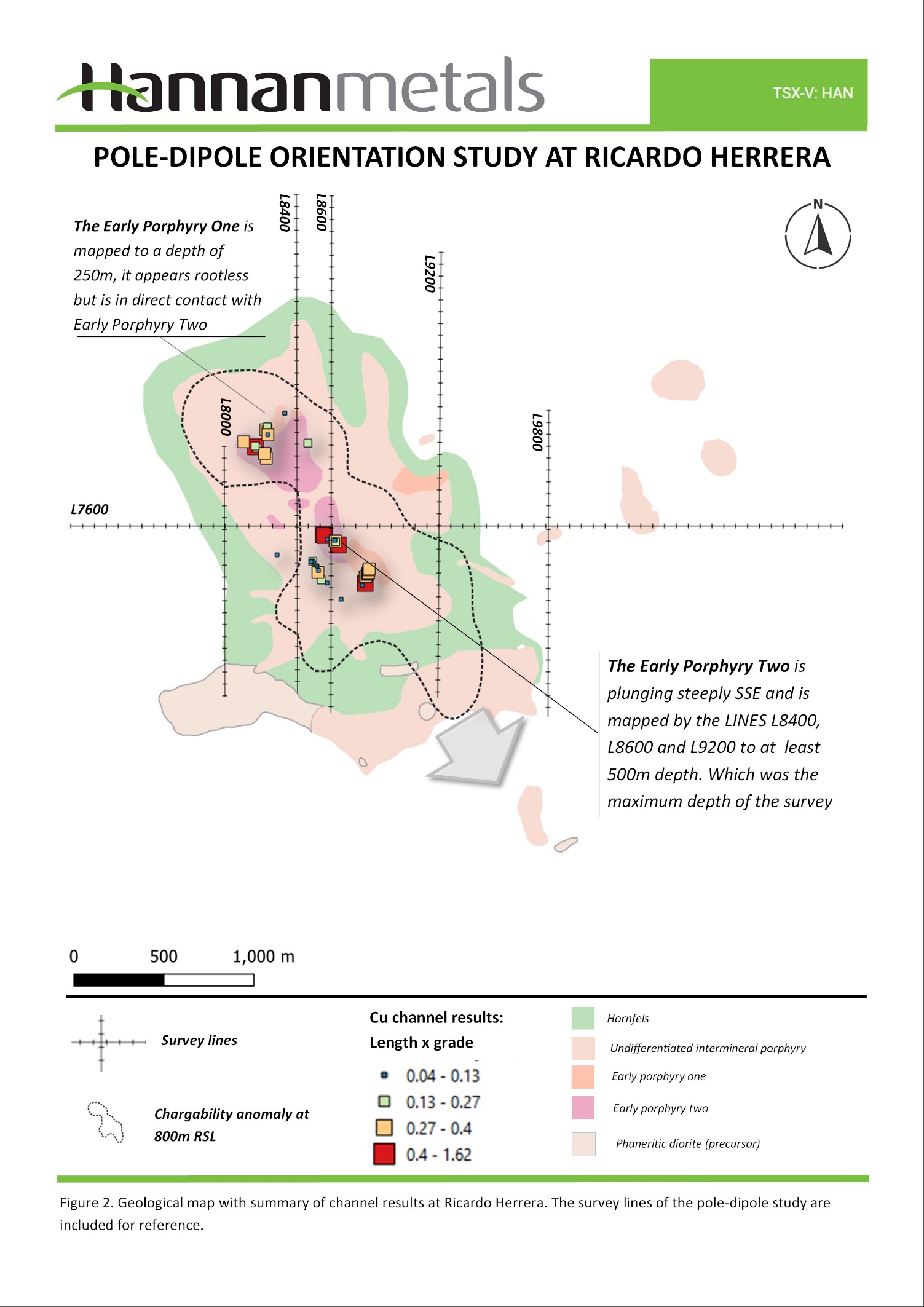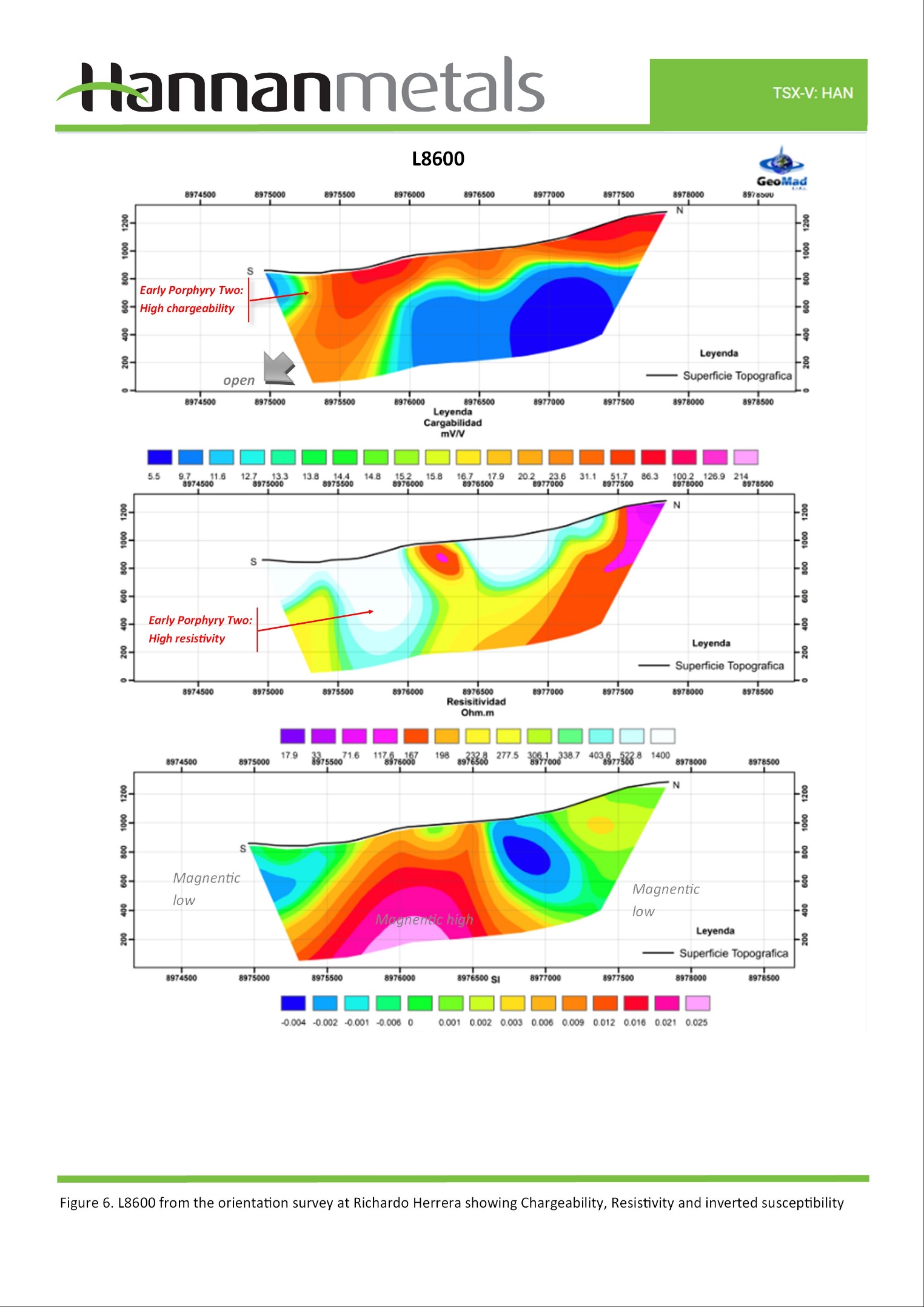VANCOUVER, BC / ACCESSWIRE / February 23, 2023 / Hannan Metals Limited ("Hannan" or the "Company") (TSXV:HAN)(OTC PINK:HANNF) is pleased to provide results from a 13.7 km Induced Polarization ("IP") geophysical survey at the Belen copper-gold ("Cu-Au") target at the 100% owned Valiente project in Peru (Figure 1).
The results of this survey at the Ricardo Herrera prospect identified two chargeable zones corresponding to two mapped porphyry units. Each represents a significant exploration target. The second target demonstrates the greatest potential with a chargeable zone over 800 m x 600 m and to at least 500 m depth which remains open.
The Belen Cu-Au porphyry is located 19 km east from the township of Tingo Maria in central Peru, within a previously unknown Miocene-age porphyry-epithermal copper-gold mineralized belt. The Belen project is contained within a 140 km by 50 km area, named the Valiente Project (Figure 1).
Highlights:
- Hannan has identified two spatially connected mineralized events at the Ricardo Herrera porphyry target at Belen, herein termed Early Porphyry One and Two.
Early Porphyry One
- New results from an IP Pole-Dipole geophysical survey mapped a combined chargeable and resistivity zone over an area of 600 m by 300 m to 250 m depth.
- This unit is dated at 15.8Ma (± 0.1Ma) and is composed of a plagioclase hornblende porphyry with intermediate argillic alteration and relics of secondary biotite. Veins are dominated by "early biotite", type M veins and type A veins. Observed sulphide minerals are pyrite, chalcopyrite, chalcocite and molybdenite.
Early Porphyry Two
- The IP Pole-Dipole geophysical survey defined a larger combined chargeable and resistivity zone over an area of 800 m by 600 m on surface, and to at least 500 m depth, to the maximum depth limits of the geophysical survey.
- This unit is dated 15.4 Ma (±0.1Ma) and 0.4 Ma younger than Early Porphyry One. It is composed of a hornblende-felspar porphyry dominated by phyllic alteration and quartz veins "type-A" with mineralization of pyrite and chalcopyrite in veinlets. To date, Early Porphyry Two demonstrates better leached geochemical results (Figure 2).
Michael Hudson, CEO, states: "Moving from the 2D space with geological mapping and geochemical data and now to the 3D space with airborne magnetics and ground-based IP geophysical surveys, we are seeing a very significant exploration target develop at Ricardo Herrera, the first of multiple porphyry targets we are exploring at Valiente. With corroborating geochemical, geological and age data we very much look forward to expanding the IP surveys and moving towards diamond drilling with the formal DIA drill permitting process now underway."
GEOLOGICAL DISCUSSION
During the last months de-risking of the Ricardo Herrera porphyry target has continued with detailed surface mapping coupled with collection of additional radiometric zircon age dating of key geological units. This work has outlined multiple intrusive events over 6 Ma window, where the Early Porphyry One and Two represent the mineralizing stages of this system. The new pole-dipole data strongly support the geological surface interpretations and further highlights the exploration opportunity at this target. Furthermore, the detailed radiometric age dating has added significant geological understanding of the mineralization at this early stage of the project.
In summary, the key geological units of Ricardo Herrera are now considered to be:
1. The precursor to the mineralization is believed to be a phaneritic medium grained diorite with a radiometric age of 21Ma (±0.1Ma). This is cut by Early Porphyry One with a radiometric age of 15.8Ma (+0.1Ma). Early Porphyry One is exposed in the northern part of Ricardo Herrera target (Figure 2).
- It is composed of a plagioclase hornblende porphyry with intermediate argillic alteration and relics of secondary biotite. It is characterized by plagioclase hornblende phenocryst, early-biotite and quartz veins (type A) and magnetite veins (type M). Observed sulphide minerals are pyrite, chalcopyrite, chalcocite and molybdenite.
- The IP Pole-Dipole IP geophysical survey mapped a combined chargeable and resistivity zone over an area of 600 m by 300 m to 250 m depth. Overall, the body seems to be rootless and is in direct contact with the northern part of Early Porphyry Two. Chargeabilities range from 20 mV/V to 40 mV/V. The high chargeability body is associated with high resistivity which is a common petrophysical correlation in porphyry deposits. See Figures 3-8 for details.
- Magnetic inversions show that this zone corresponds with lower magnetic susceptibilities (Figure 5).
- In total, 16 channels for 148 m of sampling from sporadic leached outcrops have been sampled from this unit. Samples averaged 8.7 m at 434 ppm copper and 13 ppm molybdenum, and ranged from 2.5 m to 20.2 m thickness, 316 ppm to 1,425 ppm copper, and 2.0 ppm to 98 ppm molybdenum (Figure 2).
2. Early Porphyry One is followed by an intermineral plagioclase hornblende porphyry with a radiometric age of 15.6Ma (±0.1Ma). This unit represents a cooling of the system, and the alteration and mineralization is poorer compared to previous unit.
3. Subsequently the mineral system was reactivated with a new pulse of mineralization. This is marked by the Early Porphyry Two event which has been radiometrically date at 15.4Ma (±0.1 Ma). Importantly, the second mineralized event represents a reactivation of the system and demonstrates both higher grades on surface, a larger footprint and a greater depth extent as mapped by the pole-dipole geophysical survey (Figure 3-7).
- It is composed of a hornblende-felspar porphyry dominated by phyllic alteration and quartz veins "type-A" with mineralization of pyrite and chalcopyrite in veinlets. On surface veinlets are leached and sulphide minerals are replaced by jarosite and goethite. In outcrop it demonstrates stronger alteration and surface geochemical sampling to Early Porphyry One.
- The IP Pole-Dipole geophysical survey mapped a combined chargeable and resistivity zone over an area of 800 m by 600 m on surface, and to at least 500 m depth, to the maximum depth limits of the survey and therefore remains open to depth. The body is plunging to the south-southeast and the southern proportion is under quaternary cover. Chargeabilities range from 20 mV/V to 60 mV/V. The high chargeability body is associated with high resistivity which is a common petrophysical correlation in porphyry deposits. See Figure 3-8 for details.
- Magnetic inversions show this zone corresponds to high magnetic susceptibilities, as show in Figures 5-6.
- In total, 16 channels for 67 m of sampling from sporadic leached outcrops have been sampled from this unit. Samples averaged 4.0 m at 708 ppm copper and 2 ppm molybdenum, and ranged from 1.6 m to 8.0 m thickness, 334 ppm to 1,308 ppm copper, and 0.7 ppm to 9 ppm molybdenum (Figure 2).
4. The final and terminating stages of the mineral system are marked by a second intermineral stage which is subsequently followed by a porphyry. The latter is complete unaltered and is believed to be the terminating stage of the intrusive event.
Valiente History
The 100% owned Valiente project is located in central eastern Peru, east of the city of Tingo Maria (Figure 1). The area is characterized by steep topography on the eastern flank of the Central Cordillera with elevations between 800 m and 2,000 m above sea level (a.s.l.). The project was discovered in 2021 during an extensive greenfields exploration program initiated by Hannan.
Peru has been a major copper and gold producer since precolonial times. Currently known gold deposits include orogenic gold, porphyry Cu-Au, porphyry Au, transitional porphyry-epithermal, epithermal, and placer gold. The Valiente project is a new a porphyry-epithermal metallogenic belt in the central eastern Andes. The Valiente project is located further east than most of the conventional Andean porphyry settings and shows regional similarities to deposits such as the large Bajo de Alumbrera copper-gold porphyry in Argentina. It is interpreted that Valiente was formed in a tectonically favourable area associated with an arc-oblique wrench fault system, that may have aided the ascent of oceanic arc-related magmas into the transfer zone so far inboard from the magmatic arc.
The Valiente project is believed to consist of an overlapping suit of porphyry targets with composition ranging from conventional calc-alkalic to alkalic hosted Cu-Au mineralization (reported here). It is anticipated that both high and low-magnetic and radiometric correlations may exist within the property and a detailed evaluation combining the airborne data with 3D litho-structural interpretations and results from stream sediments samples (BLEG) is currently being undertaken.
In 1984 Ingemmet, the Peruvian Geological Survey, conducted mapping in the central part of the Central Cordillera in the Departments of Huanuco and Ucayali. The area was sporadically explored during the 1990's by Gitennes, Newcrest, BHP, WMC and others but records are sparse. At this time, access to the area was restricted because of unpredictable security conditions and poor infrastructure.
From 2020 to 2021, Hannan launched a greenfields exploration program for porphyry and epithermal gold deposits in the high jungle areas of the Eastern Cordillera of Peru, which included regional database compilation, target generation, and field mapping. Hannan also conducted regional stream sediment sampling (fine clay fraction). The target generation permitted definition of prospective area, one of which was the Valiente block located along the eastern flank of the Central Cordillera, Department of Ucayali.
In 2022, field work started in the Belen area which represents a small proportion (4%) of Hannan's total landholding at Valiente. In this area, several geochemical anomalies were found, with boulders of diorite porphyry containing quartz-sulfide and magnetite veinlets. Subsequent mapping, soil and rock sampling at Belen during the last two months has identified porphyry-style alteration and veinlets.
Field and social teams are actively engaged in the area, with Hannan's policy to undertake exploration activities only within areas where full support from local stakeholders exists.
Technical Background
All channel samples were collected by Hannan geologists. Samples were transported to ALS in Lima via third party services using traceable parcels. At the laboratory, rock samples were prepared and analyzed by standard methods. The sample preparation involved crushing 70% to less than 2 mm, riffle split off 250g, pulverize split to better than 85% passing 75 microns. Samples were analyzed by method ME-MS61, a four-acid digest preformed on 0.25g of the sample to quantitatively dissolve most geological materials. Analysis is via ICP-MS. Channel samples are considered representative of the in-situ mineralization samples and sample widths quoted approximate the true width of mineralization, while grab samples are selective by nature and are unlikely to represent average grades on the property. Gold was analyzed by ALS in Lima using a standard sample preparation and 25g fire assay sample charge.
For age dating, Hannan contracted Zirchron LLC, Tucson AZ, USA to perform the dating work at Previsto. Zircons were separated from the rock matrix using an Electro Pulse Disaggregator, sieving and Wilfley water table, Frantz paramagnetic separator and heavy liquid MEI separation, before being mounted in epoxy resin discs and polished. Zircon U-Pb ages were measured at the Radiogenic Isotope and Geochronology Lab (RIGL) at WSU using an Analyte G2 193 excimer laser ablation system coupled with a Thermo-Finnigan Element 2 single-collector, inductively coupled, plasma mass spectrometer.
For the IP Geophysical survey Hannan contracted GEOMAD Servicios Generales EIRL, Lima, Peru to undertake and a Induced Polarization survey. The following survey parameters were applied: Pole-Dipole configuration with an electrode spacing of 50m, and measurements at every 50m.
About Hannan Metals Limited (TSXV:HAN)(OTC PINK:HANNF)
Hannan Metals Limited is a natural resources and exploration company developing sustainable resources of metal needed to meet the transition to a low carbon economy. Over the last decade, the team behind Hannan has forged a long and successful record of discovering, financing, and advancing mineral projects in Europe and Peru. Hannan is a top ten in-country explorer by area in Peru.
Mr. Michael Hudson FAusIMM, Hannan's Chairman and CEO, a Qualified Person as defined in National Instrument 43-101, has reviewed and approved the technical disclosure contained in this news release.
On behalf of the Board,
| Further Information |
Forward Looking Statements. Certain disclosure contained in this news release may constitute forward-looking information or forward-looking statements, within the meaning of Canadian securities laws. These statements may relate to this news release and other matters identified in the Company's public filings. In making the forward-looking statements the Company has applied certain factors and assumptions that are based on the Company's current beliefs as well as assumptions made by and information currently available to the Company. These statements address future events and conditions and, as such, involve known and unknown risks, uncertainties and other factors which may cause the actual results, performance or achievements to be materially different from any future results, performance or achievements expressed or implied by the statements. These risks and uncertainties include but are not limited to: the political environment in which the Company operates continuing to support the development and operation of mining projects; the threat associated with outbreaks of viruses and infectious diseases, including the novel COVID-19 virus; risks related to negative publicity with respect to the Company or the mining industry in general; planned work programs; permitting; and community relations. Readers are cautioned not to place undue reliance on forward-looking statements. The Company does not intend, and expressly disclaims any intention or obligation to, update or revise any forward-looking statements whether as a result of new information, future events or otherwise, except as required by law.
Neither the TSX Venture Exchange nor its Regulation Services Provider (as that term is defined in the policies of the TSX Venture Exchange) accepts responsibility for the adequacy or accuracy of this news.








SOURCE: Hannan Metals Ltd.
View source version on accesswire.com:
https://www.accesswire.com/740444/Hannan-Geophysical-Survey-Outlines-Significant-Exploration-Target-to-500-metres-Depth-at-the-Valiente-Porphyry-Project-Peru